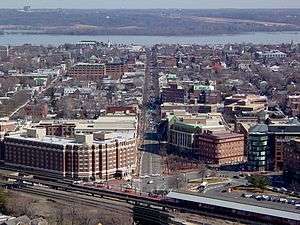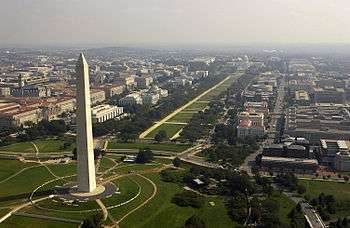Washington metropolitan area
| Washington metropolitan area (Washington – Arlington – Alexandria) | |||||
|---|---|---|---|---|---|
| Metropolitan statistical area | |||||
| |||||
| Nickname(s): DMV[1] | |||||
| Country |
| ||||
| U.S. state/federal district |
| ||||
| Principal municipalities | Washington, Arlington, Alexandria | ||||
| Area(2010) | |||||
| • Urban | 3,644.2 km2 (1,407.0 sq mi) | ||||
| • Metro | 14,412 km2 (5,564.6 sq mi) | ||||
| Elevation | 0–716 m (0–2,350 ft) | ||||
| Population (2014)[2] | |||||
| • Metropolitan statistical area | 6,097,684 (7th) | ||||
| • Density | 418.7/km2 (1,084/sq mi) | ||||
| • Urban | 4,586,770 (8th) | ||||
| • CSA | 9,546,579 (4th) | ||||
| MSA = 2014, CSA = 2014, Urban & Densities = 2010 | |||||
| Time zone | ET (UTC-5) | ||||
| • Summer (DST) | EST (UTC-4) | ||||
The Washington metropolitan area is the metropolitan area centered on Washington, D.C., the capital of the United States. The area includes all of the federal district and parts of the U.S. states of Maryland and Virginia, along with a small portion of West Virginia.
The Washington metropolitan area is the most educated and, by some measures, the most affluent metropolitan area in the United States.[3] As of the 2014 U.S. Census Bureau estimate, the population of the Washington metropolitan area was estimated to be 6,097,684, making it the largest metropolitan area in the Southeast and the sixth-largest metropolitan area in the country.[4]
Nomenclature
The U.S. Office of Management and Budget defines the area as the Washington–Arlington–Alexandria, DC–VA–MD–WV metropolitan statistical area, a metropolitan statistical area used for statistical purposes by the United States Census Bureau and other agencies. The region's three largest cities are the federal territory of Washington, D.C., the county (and Census-designated place) of Arlington, and the independent city of Alexandria. The Office of Management and Budget also includes the metropolitan statistical area as part of the larger Baltimore–Washington metropolitan area, which has a population of 9,546,579 as of the 2014 Census Estimate.[5]
The area is also sometimes referred to as the National Capital Region, particularly by federal agencies such as the military[6] Department of Homeland Security.[7] Another term used to describe the region is the D.C. Area. The area is increasingly referred to as the DMV, a shorthand for the District of Columbia, Maryland, and Virginia.[1][8] The area in the region that is surrounded by Interstate 495 is also referred to as being "inside the Beltway". The city of Washington, which is at the center of the area, is referred to as "the District" because it is the federal District of Columbia, and is not part of any state. The Virginian portion of the region is known as Northern Virginia.
Composition
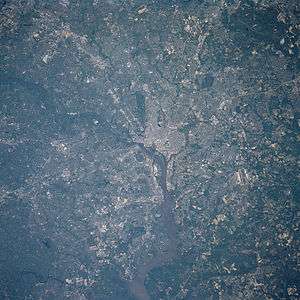


The U.S. Census Bureau divides the Washington statistical metropolitan area into two metropolitan divisions:[9]
- Washington–Arlington–Alexandria, DC–VA–MD–WV Metropolitan Division, comprising the majority of the metropolitan area
- Silver Spring–Frederick–Rockville, MD Metropolitan Division, consisting of Montgomery and Frederick counties
Note that metropolitan area and metropolitan statistical area should not be confused with Metropolitan Division.
Political subdivisions
The area includes the following counties, districts, and independent cities:[9]
District of Columbia
Maryland
Virginia
 Alexandria
Alexandria Arlington County
Arlington County Clarke County
Clarke County Culpeper County
Culpeper County Fairfax County
Fairfax County- Fairfax
- Falls Church
- Fauquier County
 Loudoun County
Loudoun County- Manassas
- Manassas Park
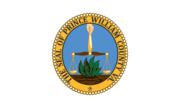 Prince William County
Prince William County- Rappahannock County
- Spotsylvania County
- Stafford County
 Fredericksburg
Fredericksburg- Warren County
West Virginia
Regional organizations
Metropolitan Washington Council of Governments
Founded in 1957, the Metropolitan Washington Council of Governments (MWCOG) is a regional organization of 21 Washington-area local governments, as well as area members of the Maryland and Virginia state legislatures, the U.S. Senate, and the U.S. House of Representatives. MWCOG provides a forum for discussion and the development of regional responses to issues regarding the environment, transportation, public safety, homeland security, affordable housing, community planning, and economic development.[10]
The National Capital Region Transportation Planning Board, a component of MWCOG, is the federally designated metropolitan planning organization for the metropolitan Washington area.[11]
Principal cities

The metropolitan area includes the following principal cities (not all of which are incorporated as cities; one, Arlington, is actually a county, and another, Bethesda, is not even a city, simply a census-designated unincorporated area):[12]
- Washington, D.C.
- Arlington, Virginia
- Alexandria, Virginia
- Bethesda, Maryland
- Frederick, Maryland
- Gaithersburg, Maryland
- Reston, Virginia
- Rockville, Maryland
- Silver Spring, Maryland
Demographics
| Year | DEM | GOP | Others |
|---|---|---|---|
| 2012 | 67.5% 1,813,963 | 30.9% 829,567 | 1.7% 44,708 |
| 2008 | 68.0% 1,603,902 | 31.0% 728,916 | 1.0% 25,288 |
| 2004 | 61.0% 1,258,743 | 38.0% 785,144 | 1.4% 19,735 |
| 2000 | 58.5% 1,023,089 | 37.9% 663,590 | 3.6% 62,437 |
| 1996 | 57.0% 861,881 | 37.0% 558,830 | 6.0% 89,259 |
| 1992 | 53.0% 859,889 | 34.1% 553.369 | 12.9% 209,651 |
| 1988 | 50.4% 684,453 | 48.6% 659,344 | 1.0% 14,219 |
| 1984 | 51.0% 653,568 | 48.5% 621,377 | 0.4% 5,656 |
| 1980 | 44.7% 484,590 | 44.6% 482,506 | 11.1% 115,797 |
| 1976 | 54.2% 590,481 | 44.9% 488,995 | 1.0% 10,654 |
| 1972 | 44.2% 431,257 | 54.8% 534,235 | 1.1% 10,825 |
| 1968 | 49.4% 414,345 | 39.1% 327,662 | 11.5% 96,701 |
| 1964 | 69.8% 495,490 | 30.2% 214,293 | 0.1% 462 |
| 1960 | 52.5% 204,614 | 47.3% 184,499 | 0.1% 593 |
.jpg)
Old Town Alexandria, Joint Base Anacostia-Bolling, and National Harbor, Maryland are visible.
Politics
The relative strength of the major political parties within the region is shown by the presidential election results since 1960, as presented in the adjacent table.
Racial composition
The area has been a magnet for international immigration since the late 1960s. It is also a magnet for internal migration (persons moving from one region of the U.S. to another).[13] Census estimates show that persons of post-1965 immigrant stock will likely represent 25% of the region's population by 2010, forming a bigger population bloc than native blacks for the first time.[14]
Racial composition of the Washington, D.C. area:
- 2011 American Community Survey
- Non-Hispanic White : 48.2%
- Black or African American : 25.3%
- Hispanic or Latino : 14.1%
- Asian : 9.3%
- Mixed and Other : 3.1%
- 2010 U.S. Census
- White : 54.8%
- Black : 25.8%
- Asian : 9.3%
- Hispanic : 13.8% (4.1% Salvadoran, 2.1% Mexican, 1.1% Colombian, 0.9% Guatemalan, 0.9% Puerto Rican, 0.8% Peruvian, 0.7% Honduran, 0.7% Bolivian)
- Mixed and Other : 3.7%
- 2006[15]
- 1980
- White : 67.8%
- Black : 26.0%
- Asian : 2.5%
- Hispanic : 2.8%
- Mixed and Other : 0.9%
Social indicators
The Washington metropolitan area has ranked as the highest-educated metropolitan area in the nation for four decades.[16] As of the 2006–2008 American Community Survey, the three most educated places with 200,000 people or more in Washington–Arlington–Alexandria by bachelor's degree attainment (population 25 and over) are Arlington, Virginia (68.0%), Fairfax County, Virginia (58.8%), and Montgomery County, Maryland (56.4%).[17] Forbes magazine stated in its 2008 "America's Best- And Worst-Educated Cities" report: "The D.C. area is less than half the size of L.A., but both cities have around 100,000 Ph.D.'s."[18]
The Washington, D.C. metro area has held the top spot in the American College of Sports Medicine's annual American Fitness Index ranking of the United States' 50 most populous metropolitan areas for two years running. The report cites, among other things, the high average fitness level and healthy eating habits of residents, the widespread availability of health care and facilities such as swimming pools, tennis courts, and parks, low rates of obesity and tobacco use relative to the national average, and the high median household income as contributors to the city's community health.[19]
.jpg)
In the 21st century, the Washington metropolitan area has overtaken the San Francisco Bay Area as the highest-income metropolitan area in the nation.[3] The median household income of the region is US$72,800. The two highest median household income counties in the nation – Loudoun and Fairfax County, Virginia – are components of the MSA (and #3 is Howard County, officially in Baltimore's sphere but strongly connected with Washington's); measured in this way, Alexandria ranks 10th among municipalities in the region – 11th if Howard is included – and 23rd in the entire United States. 12.2% of Northern Virginia's 881,136 households, 8.5% of suburban Maryland's 799,300 households, and 8.2% of Washington's 249,805 households have an annual income in excess of $200,000, compared to 3.7% nationally.[21]
According to a report by the American Human Development Project, women in the Washington metropolitan area are ranked as having the highest income and educational attainment among the 25 most populous metropolitan areas in the nation, while Asian American women in the region had the highest life expectancy, at 92.3 years.[22]
Economy
.jpg)
The various agencies of the Federal Government employ over 140,000 professionals in the Washington D.C. area. A sizable number in the Washington D.C. area work for defense and civilian contracting companies that conduct business directly with the Federal Government (many of these firms are referred to as 'Beltway Bandits' under the local vernacular). As a result, the Federal Government provides the underlying basis of the economy in the region. However, the Washington D.C. area is increasingly home to a diverse segment of businesses not directly related to the Federal Government.
The Washington, D.C. area has the largest science and engineering work force of any metropolitan area in the nation in 2006 according to the Greater Washington Initiative at 324,530, ahead of the combined San Francisco Bay Area work force of 214,500, and Chicago metropolitan area at 203,090, citing data from U.S. Census Bureau, the Bureau of Labor Statistics, Claritas Inc., and other sources.[3]
The Washington, D.C. area was ranked as the second best High-Tech Center in a statistical analysis of the top 100 Metropolitan areas in the United States by American City Business Journals in May 2009, behind the Silicon Valley and ahead of the Boston metropolitan area.[25] Fueling the metropolitan area's ranking was the reported 241,264 tech jobs in the region, a total eclipsed only by New York, Los Angeles, and the combined San Jose–San Francisco–Oakland regions, as well as the highest master's or doctoral degree attainment among the 100 ranked metropolitan areas.[25] A Dice.com report showed that the Washington–Baltimore area had the second-highest number of tech jobs listed: 8,289, after the New York metro area with 9,195 jobs.[26]
The Washington D.C. area is home to hundreds of major research universities, think tanks, and non-profit organizations. Additionally, Washington, D.C. is a top tourism destination as flocks of Americans and foreigners from around the world visit the museums and monuments of the Capital city year round with the peak season being during the spring and summer months of April through August. Moreover, the Washington D.C. area attracts tens of major conferences and conventions each year which also contribute greatly to the region's economy.
Changes in house prices for the D.C. area are publicly tracked on a regular basis using the Case–Shiller index; the statistic is published by Standard & Poor's and is also a component of S&P's 10-city composite index of the value of the U.S. residential real estate market.
McLean ZIP code 22102 had the highest median home prices among ZIP codes within the Washington metropolitan area as of 2013.[27]
Primary industries
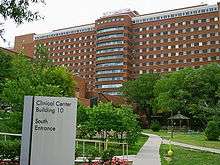
Biotechnology
Not limited to its proximity to the National Institutes of Health, Maryland's Washington suburbs are a major center for biotechnology. Prominent local biotech companies include GSK, MedImmune, The Institute for Genomic Research, and the Howard Hughes Medical Institute.
Defense contracting
Many defense contractors are based in the region to be close to the Pentagon in Arlington. Local defense contractors include Lockheed Martin, the largest, as well as Raytheon, General Dynamics, BAE Systems, Northrup Grumman,[28] Computer Sciences Corporation (CSC), Science Applications International Corporation (SAIC), CACI, and Orbital Sciences Corporation.
Largest companies
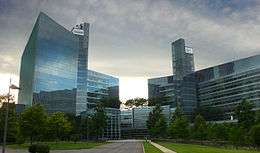
The following Fortune 500 companies are headquartered in the region:[29]
| Company | Industry | Headquarters | Fortune 500 rank |
|---|---|---|---|
| AES Corporation | Energy | Arlington, Virginia | 174 |
| Booz Allen Hamilton | Defense | McLean, Virginia (Tysons Corner) | 443 |
| Capital One | Finance | McLean, Virginia (Tysons Corner) | 124 |
| Computer Sciences Corporation | Defense | Falls Church, Virginia | 185 |
| Danaher Corporation | Conglomerate | Washington, D.C. | 149 |
| Discovery Communications | Media | Silver Spring, Maryland | 460 |
| Fannie Mae | Finance | Washington, D.C. | 13 |
| Freddie Mac | Finance | McLean, Virginia (Tysons Corner) | 32 |
| Gannett Company | Media | McLean, Virginia (Tysons Corner) | 481 |
| General Dynamics | Defense | Falls Church, Virginia | 99 |
| Hilton Worldwide Holdings Inc. | Hospitality | McLean, Virginia (Tysons Corner) | 289 |
| Host Hotels and Resorts | Hospitality | Bethesda, Maryland | 477 |
| Leidos Holdings Inc. | Defense | Reston, Virginia | 442 |
| Lockheed Martin | Defense | Bethesda, Maryland | 59 |
| Marriott International | Hospitality | Bethesda, Maryland | 219 |
| Northrop Grumman | Defense | Falls Church, Virginia | 122 |
History

The 2005 Base Realignment and Closure resulted in a significant shuffling of military, civilian, and defense contractor employees in the Washington D.C. area. The largest individual site impacts of the time are as follows:[30]
- Fort Belvoir gained 11,858 employees, primarily as a result of the relocation of the National Geospatial-Intelligence Agency (NGA) into a massive new headquarters within the fort.
- Fort Lee gained 7,344 mostly military employees.
- Fort Meade gained 5,361 employees, primarily as a result of the expansion of the National Security Agency.
- Walter Reed Army Medical Center lost 5,630 employees as part of its realignment. It was later closed and consolidated into Walter Reed National Military Medical Center.
BRAC 2005 was the largest infrastructure expansion by the Army Corps of Engineers since World War II, resulting in the Mark Center, tallest building they have ever constructed, as well as National Geospatial-Intelligence Agency Campus East, which at 2.4 million square feet is the largest building the Corps have constructed since the Pentagon.[31]
Transportation
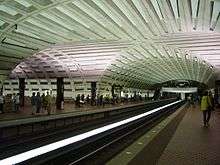
'WMATA'-indicated systems are run by Washington Metropolitan Area Transit Authority and always accept Washington Metro fare cards, others may or may not.
Major airports
- Washington Dulles International Airport (IAD), located in Dulles, Virginia – the busiest in the region
- Ronald Reagan Washington National Airport (DCA), located in Arlington County, Virginia – the closest to Washington
- Baltimore–Washington International Thurgood Marshall Airport (BWI), located in Linthicum, Maryland – in the Baltimore metropolitan area and the busiest in the Baltimore-Washington area
Rail transit systems
- Washington Metro – DC, MD, VA (rapid transit) (WMATA)
- MARC Train – DC, MD, WV (commuter rail)
- Virginia Railway Express – DC, VA (commuter rail)
- Amtrak – US (commuter rail, inter-city rail)
Bus transit systems
- DC Circulator – Washington, D.C. (DDoT, WMATA)
- Metrobus – Washington metropolitan area (WMATA)
- Metroway – Arlington County, Virginia and Alexandria, Virginia (bus rapid transit) (WMATA)
- Ride On – Montgomery County, Maryland
- TheBus – Prince George's County, Maryland
- ART – Arlington County, Virginia
- DASH – Alexandria, Virginia
- Fairfax Connector – Fairfax County, Virginia
- CUE Bus – Fairfax, Virginia
- Loudoun County Transit – Loudoun County, Virginia
- PRTC – Prince William County, Manassas and Manassas Park
- TransIT – Frederick County, Maryland
- Regional Transportation Agency of Central Maryland – Howard County, Anne Arundel County, Prince George's County, Laurel, Maryland
- Maryland Transit Administration – Washington, D.C., Montgomery County, Maryland, Prince George's County, Frederick County, Maryland, Charles County, Maryland, Calvert County, Maryland, Howard County, Anne Arundel County, Saint Mary's County, Maryland
- Eastern Panhandle Transit Authority – Jefferson County, West Virginia, Berkeley County, West Virginia
- Virginia Regional Transit – Loudoun County, Virginia, Fauquier County, Virginia, Warren County, Virginia
- Fredericksburg Regional Transit – Fredericksburg, Spotsylvania County and Stafford County
Bicycle sharing systems
- Capital Bikeshare - Washington, D.C., Arlington, Virginia, Alexandria, Virginia, and Montgomery County, Maryland
Culture
Sports teams
Listing of the professional sports teams in the Washington metropolitan area:
- National Basketball Association (NBA)
- Major League Baseball (MLB)
- National Football League (NFL)
- National Hockey League (NHL)
- Major League Soccer (MLS)
- Women's National Basketball Association (WNBA)
- Atlantic League of Professional Baseball (ALPB)
- Arena Football League (AFL)
- National Women's Soccer League (NWSL)
Media
The Washington metropolitan area is home to USA Today, C-SPAN, PBS, NPR, POLITICO, BET, TV One and Discovery Communications. The two main newspapers are The Washington Post and The Washington Times. Local television channels include WRC-TV 4 (NBC), WTTG 5 (FOX), WJLA 7 (ABC), WUSA 9 (CBS), WDCA 20 (MyNetworkTV), WETA-TV 26 (PBS), WDCW 50 (CW), and WPXW 66 (Ion). NewsChannel 8 is a 24/7 local news provider available only to cable subscribers. Radio stations serving the area include: WETA-FM, WIHT, WMAL-AM, and WTOP.
Area codes
- 202 – Washington, D.C.
- 571/703 – Northern Virginia including the cities of Alexandria, Fairfax, and Falls Church as well as Arlington, Fairfax, and Loudoun counties (571 created 1 March 2000; 703 in October 1947).
- 240/301 – portions of Maryland in the Greater Washington, D.C. metro area, southern Maryland, and western Maryland
- 540 – Fredericksburg/Spotsylvania/Warrenton
- 304 – Jefferson County, West Virginia
Sister cities
| City | Country | Year |
|---|---|---|
| Washington, D.C. | ||
| Bangkok | |
1962, renewed 2002 |
| Dakar | |
1980, renewed 2006 |
| Beijing | |
1984, renewed 2004 |
| Brussels | |
1985, renewed 2012 |
| Athens | |
2000 |
| Paris[Note 1] | |
2000, renewed 2005 |
| Pretoria | |
2002, renewed 2008 |
| Seoul | |
2006 |
| Accra | |
2006 |
| Sunderland | |
2006 |
| Alexandria, Virginia | ||
| Gyumri | |
|
| Helsingborg | |
|
| Dundee[Note 2] | |
|
| Caen | |
|
| Arlington County, Virginia | ||
| Aachen | |
|
| Reims | |
|
| San Miguel | |
|
| Coyoacán | |
|
| Ivano-Frankivsk[Note 3] | |
|
| Herndon, Virginia | ||
| Runnymede[Note 4] | |
|
| Fairfax County, Virginia | ||
| Harbin[Note 5] | |
2009 |
| Songpa-gu[Note 6] | |
2009 |
| Falls Church, Virginia | ||
| Kokolopori | |
|
| District Heights, Maryland | ||
| Mbuji-Mayi | |
|
| Frederick, Maryland | ||
| Aquiraz | |
|
| Moerzheim | |
|
| Schifferstadt | ||
| La Plata, Maryland | ||
| Jogeva County | |
|
| Walldorf | |
|
| Rockville, Maryland | ||
| Pinneberg | |
- ↑ Paris is a "Partner City" due to the one Sister City policy of that commune.
- ↑ "Historic Alexandria | City of Alexandria, VA". Oha.alexandriava.gov. Retrieved 2012-11-19.
- ↑ Exploration phase
- ↑ Town twin
- ↑ Rejected by Washington due to not being a national capital.
- ↑ "Sisterhood Partnerships". Fairfaxcounty.gov. Retrieved 2012-11-19.
See also
- List of people from the Washington, D.C. metropolitan area
- List of U.S. metropolitan statistical areas in Virginia
- Potomac primary
- Northeast megalopolis
References
- 1 2 "After initial obscurity, 'The DMV' nickname for Washington area picks up speed". Washington Post. July 30, 2010.
- ↑ (Table of United States Metropolitan Statistical Areas)
- 1 2 3 "Washington area richest, most educated in US: report". Washingtonpost.com. 2006-06-08. Retrieved 2012-11-19.
- ↑ "Four Texas Metro Areas Collectively Add More Than 400,000 People in the Last Year, Census Bureau Reports". United States Census Bureau.
- ↑ . Census.gov. Retrieved on 2016-01-12.
- ↑ http://www.capitalregionupdates.gov/go/doc/4063/1130963/About-the-National-Capital-Region-NCR-
- ↑ "National Capital Region – Office of National Capital Region Coordination". Department of Homeland Security. December 21, 2005. Archived from the original on 2007-12-12. Retrieved 2008-01-09.
- ↑ Yager, Jane (July 30, 2010). "Nation's Capitol Now Known as 'the DMV'". Newser. Retrieved March 11, 2016.
an increasingly known and used acronym for District / Maryland / Virginia
- 1 2 "Revised Delineations of Metropolitan Statistical Areas, Micropolitan Statistical Areas, and Combined Statistical Areas, and Guidance on Uses of the Delineations of These Areas" (PDF). Office of Management and Budget. February 20, 2013. Retrieved 2013-05-09.
- ↑ "About Us". MWCOG.org. Retrieved 2012-11-19.
- ↑ "– Transportation – TPB". Mwcog.org. Retrieved 2012-11-19.
- ↑ "OMB Bulletin No. 13-01: Revised Delineations of Metropolitan Statistical Areas, Micropolitan Statistical Areas, and Combined Statistical Areas, and Guidance on Uses of the Delineations of These Areas" (PDF). U.S. Office of Management and Budget. February 28, 2013. Retrieved May 14, 2014.
- ↑ "Metro Magnets for Minorities and Whites: Melting Pots, the New Sunbelt, and the Heartland" (PDF). Retrieved 2012-11-19.
- ↑ "Annual Estimates of the Resident Population by Age, Sex, Race and Hispanic Origin for Counties: April 1, 2000 to July 1, 2007". Archived from the original on June 10, 2010. Retrieved January 12, 2016.
- ↑ "Annual Estimates of the Resident Population by Sex, Race Alone and Hispanic or Latino Origin for Counties: April 1, 2000 to July 1, 2006". Archived from the original on June 10, 2010. Retrieved January 12, 2016.
- ↑ de Vise, Daniel (2010-07-15). "Washington region ranks as the best-educated in the country". Washingtonpost.com. Retrieved 2012-11-19.
- ↑ "2006–2008 American Community Survey 3-Year Estimates". Census.gov. Retrieved 2012-11-19.
- ↑ Zumbrun, Joshua (2008-11-24). "America's Best- And Worst-Educated Cities". Forbes.com. Retrieved 2012-11-19.
- ↑ "Washington, DC (Washington–Arlington–Alexandria, DC–VA–MD–WV MSA) 2010 AFI Report" (PDF). Retrieved 2010-05-26.
- ↑ "Macerich Tysons Corner Center Market Profile" (PDF).
- ↑ "ACS 2005–2007". Census.gov. Retrieved 2012-11-19.
- ↑ "Women'S Well-Being" (PDF). Retrieved 2012-11-19.
- ↑ Downey, Kirstin (2007-05-06). "High-Rises Approved That Would Dwarf D.C". Washingtonpost.com. Retrieved 2012-11-19.
- ↑ "List of tallest buildings in DC, MD, VA, WV". Skyscraperpage.com. Retrieved 2012-11-19.
- 1 2 "The top 100 tech centers". Bizjournals. 2009-05-11. Archived from the original on February 16, 2010. Retrieved 2010-03-03.
- ↑ Nathan Eddy (2012-03-13). "Tech Jobs Flourish in Silicon Valley, but Other Regions Offer Opportunities: Dice Report". Eweek.com. Retrieved 2012-11-19.
- ↑ Brennan, Morgan. "America's Most Expensive Zip Codes In 2013: The Complete List". Forbes. Archived from the original on March 4, 2016.
- ↑ Censer, Marjorie (July 30, 2010). "Defense firm Northrop Grumman's second-quarter profit rose nearly 81 percent". The Washington Post.
- ↑ "Fortune 500". Fortune.com.
- ↑ Appendix C BRAC 2005 Closure and Realignment Impacts by State
- ↑ Justin Matthew Ward (14 September 2011). "BRAC 2005: on time, on budget in Northeast". army.mil.
External links
| Wikivoyage has a travel guide for Washington, D.C. area. |
- OMB Bulletin No. 05-02
- Urban Areas of Virginia
- May 2006 Metropolitan and Nonmetropolitan Area Occupational Employment and Wage Estimates; Washington–Arlington–Alexandria, DC–VA–MD–WV Metropolitan Division
- May 2005 Metropolitan Area Occupational Employment and Wage Estimates; Washington–Arlington–Alexandria, DC–VA–MD–WV Metropolitan Division
- Washington–Arlington–Alexandria, DC–VA–MD–WV MSA Population and Components of Change
Coordinates: 38°53′12.33″N 77°2′29.85″W / 38.8867583°N 77.0416250°W
